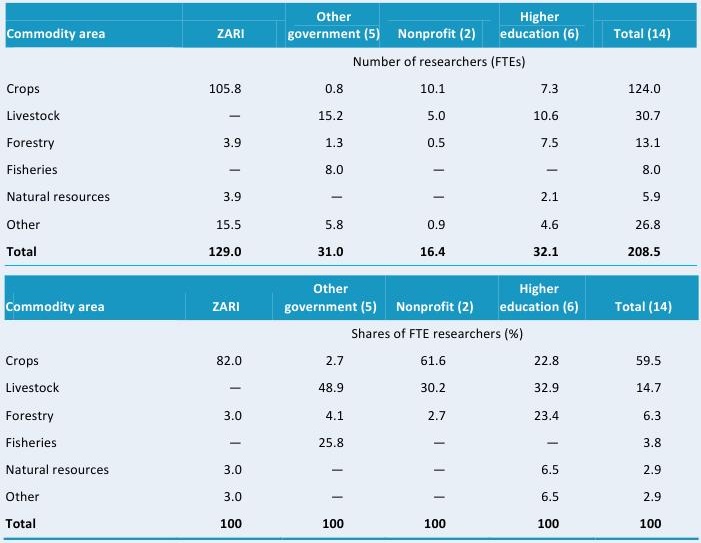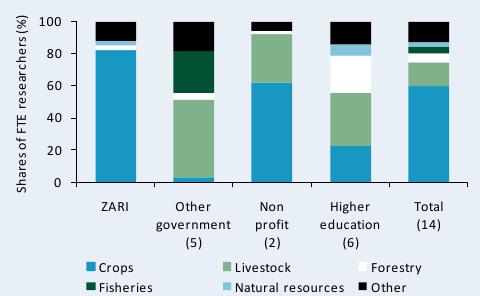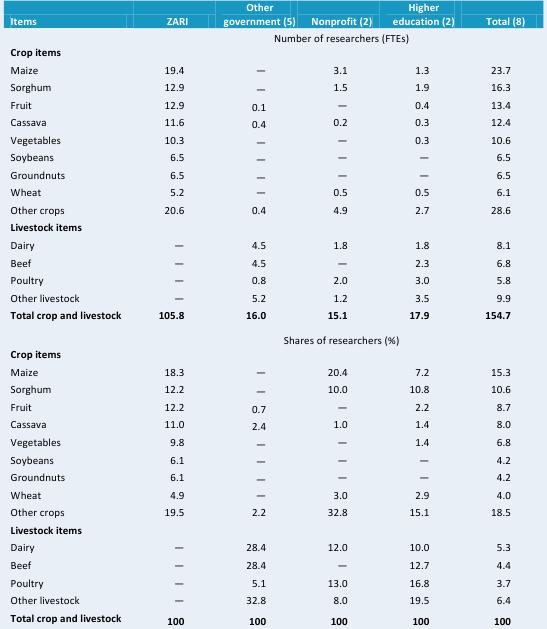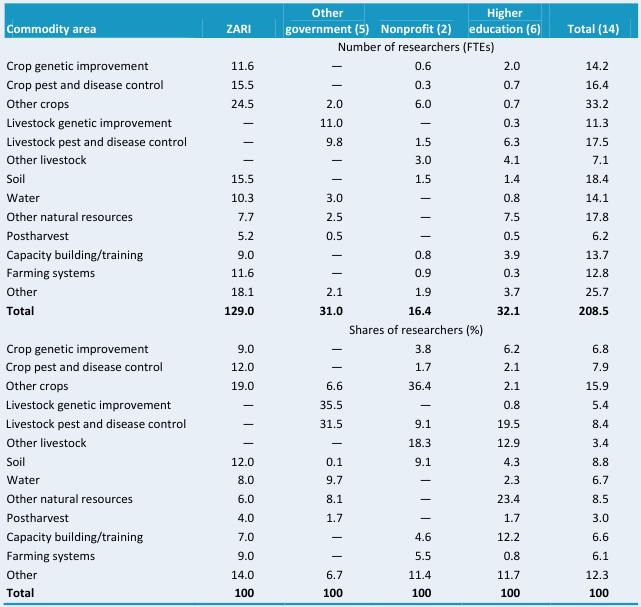The ASTI Data in Focus series provides additional background data in support of the 2010
Country Note on Zambia (asti.cgiar.org/pdf/Zambia-Note.pdf) prepared by the Agricultural Science and Technology Indicators (ASTI) initiative. Based on data collected by ASTI, these two outputs review major investment and capacity trends in Zambian public agricultural research and development (R&D) since 1971, providing important updates on agricultural R&D trends prepared by ASTI in 2000–03.
D. Research Allocation across Commodities and Themes
This section provides detailed quantitative information on Zambian public agricultural research allocation in 2008. Complementary sections of this issue on Zambia present detailed data on long-term trends (Section A), financial resources (Section B), and human resources (Section C). Further supporting information provides macroeconomic trends, a list of agencies included in the study, data sources and estimation procedures, and ASTI’s methodology.
Table D1—Research focus by major commodity area, 2008
This table presents researcher numbers by major commodity area, both in absolute and relative terms. In 2008, 124 of Zambia’s 209 full-time equivalent (FTE) researchers focused on crop research. Of the remaining researchers, 31 FTEs focused on livestock, 13 FTEs focused on forestry, 8 FTEs focused on fisheries, 6 FTEs focused on natural resources, and 27 FTEs focused on other commodity areas. Notably, while 82 percent of researchers employed at the Zambia Agriculture Research Institute (ZARI) focused on crop research, those as the remaining five government agencies focused on noncrop areas, such as livestock and fisheries.

Source: Calculated by authors from ASTI 2009.
Note: Figures in parentheses indicate the number of agencies in each category.
Figure D1—Research focus by major commodity area, 2008
This figure presents the allocation of FTE researchers across different commodity areas (see also Table D1). In 2008, 60 percent of the country’s FTE researchers in agriculture were involved in crop research. Livestock research accounted for 15 percent, forestry research for 6 percent, fisheries research for 4 percent, and natural resources for 3 percent. The remaining researchers concentrated on agricultural engineering, socioeconomic research, postharvest research, or other matters. The focus of research varied widely across agencies. For example, 82 percent of the FTE researchers employed at ZARI and 62 percent of those employed at nonprofit agencies focused on crops, whereas few FTEs at the other government and higher education agencies focused on crop research.

Source: Calculated by authors from ASTI 2009.
Note: Figures in parentheses indicate the number of agencies in each category.
Table D2—Focus of crop and livestock research by major item, 2008
The most researched crops in Zambia in 2008 were maize and sorghum, accounting for 24 and 16 FTE researchers, or 15 and 11 percent of the total crop and livestock researchers, respectively. Other important crops included fruit, cassava, and vegetables, each accounting for between 7 and 9 percent of researchers. The country’s livestock researchers concentrated primarily on issues relating to dairy (5 percent), beef (4 percent), and poultry (4 percent).

Source: Calculated by authors from ASTI 2009.
Notes: Figures in parentheses indicate the number of agencies in each category. Of the 14 sample agencies, 2 government and 4 higher education agencies conducted no crop or livestock research.
Table D3—Focus of crop and livestock research by major theme, 2008
This table presents FTE researchers by thematic area in absolute and relative terms. Crops are the most important research theme in Zambia, accounting for 64 of the 209 FTE researchers employed in 2008. That year, 7 percent of Zambia’s agricultural researchers focused on crop genetic improvement, 8 percent focused on crop pest and disease control, and another 16 percent focused on other research related to crops. Natural resource research was another important area, accounting for 24 percent of the country’s agricultural researchers. As usual, large variations were reported across agencies.

Source: Calculated by authors from ASTI.
Note: Figures in parentheses indicate the number of agencies in each category.
